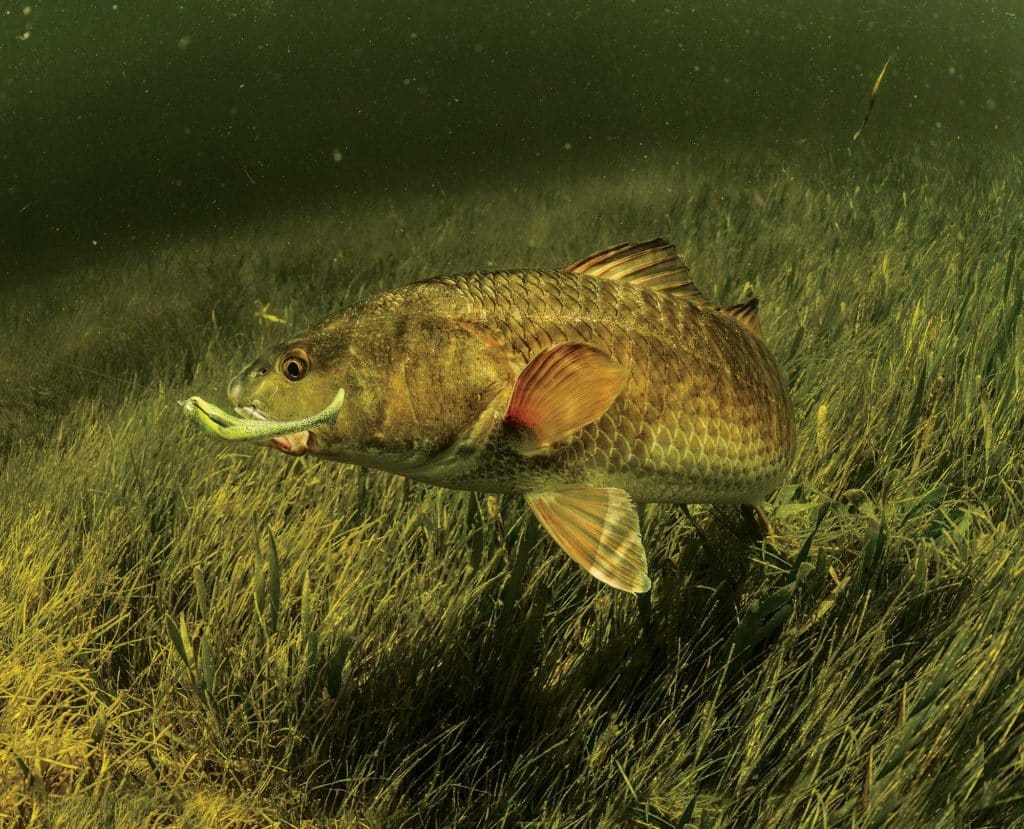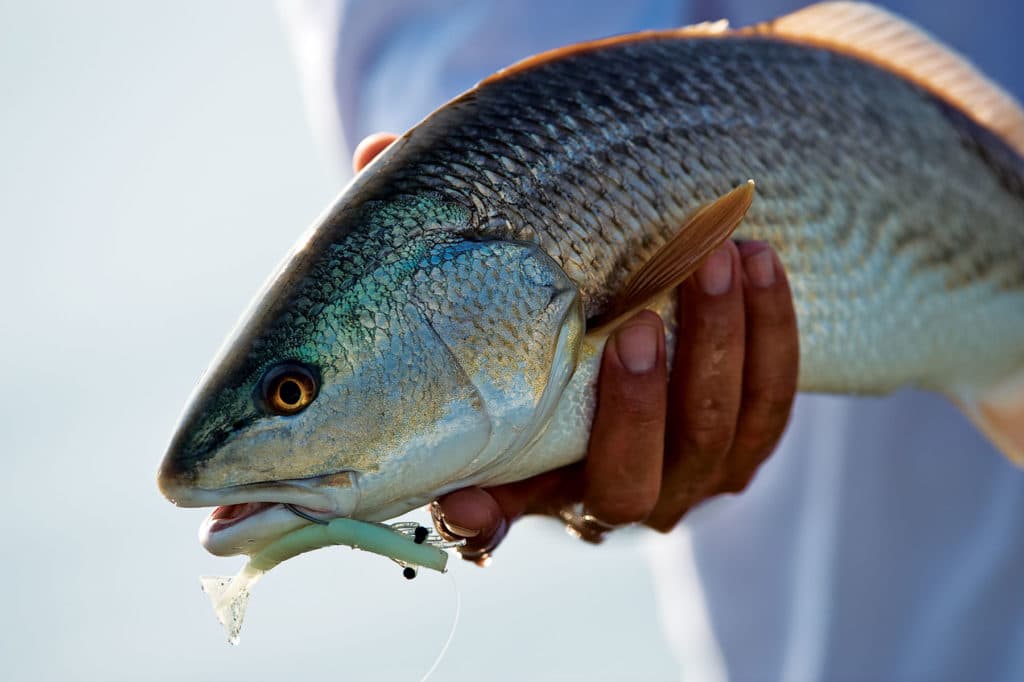
Probably few things annoy an angler more than perfectly delivering a cast to a spot you know holds fish only to have the hook on your soft-plastic lure immediately snag some sea grass, a stick, an oyster bar or rocky bottom.
“If you throw a lure out in front of a fish and it gets hung up, you either have to rip it out of the grass and it runs right by the fish, or it’s hung up and a big, ol’ wad of grass spooks the fish,” says professional redfish tournament fisherman Mark Cowart, of Panama City Beach, Florida.
To avoid that, top anglers and guides rig their soft-plastic baits on hooks and jig heads to run weedless. The key is to essentially hide the hook point, a goal they achieve using a variety of hooks and other terminal tackle.

Hide The Hook in the Soft Plastic
Capt. Gary Dubiel of Oriental, North Carolina, is a Rapala pro staffer who fishes Storm’s 360GT Coastal soft plastics. The 360GTs feature slots in the belly and back so the hook point remains hidden, not protruding from the bait. The lures come pre-rigged with either a VMC Coastal Black jig head or a VMC Coastal Black Hook with Keel Weight.
Instead of fishing them on a jig head, where the hook would be exposed, Dubiel prefers the weighted hook, which he says is “fairly lightweight and designed primarily for fishing shallow grass flats in Florida. If you want to get deeper, you need to use a little bit heftier weight.” In that case, Dubiel rigs the lures on a VMC Heavy Duty Weighted Swimbait hook. The wide-gap hook features a locking spring that screws into the head of the bait and a weight on the shank. He uses 3/0 and 4/0 hooks, going bigger for thicker baits.
“I put the hook point into the body of the bait, and when it comes out, it actually sits in the groove on top,” explains Dubiel, who targets speckled trout, redfish and striped bass. “It’s outside the plastic, but the point is protected. It’s pretty smooth going through the grass. And the keel weight has a tendency to keep the lure a little cleaner, whether you’re fishing grass, wood or oyster shells.”

Capt. Ed Zyak of D.O.A. Lures in Stuart, Florida, says the company works with Eagle Claw to design hooks customized for its baits. D.O.A.’s PT-7 topwater lure comes with a 7/0 extra-wide-gap spring-screw TroKar hook with a needle point instead of the standard triangular point.
“The triangular point cut through the PT-7 easier than the needle point, which doesn’t rip out of the bait as easily and still has an extremely sharp point, plus we needed a bigger gap for the PT-7 for better hookups,” says Zyak, who also fishes the hook with a 5.5-inch jerk bait, 4-inch shad, and 5-inch swimbait for snook, redfish, and trout. “What makes it good is it’s a very strong, very stout hook. And because the wide gap drops down so far, it acts like a keel, which makes the baits swim true.”
Zyak skin-hooks the lures, going through the top of the bait with the hook point, then barely sticking the point back into the lure. He does the same with the 3/0 Needlepoint Screw Hook that Eagle Claw makes for D.O.A.’s 3-inch C.A.L. Shad and 4-inch C.A.L. jerkbait. He adds that a benefit of the spring screw, besides easy rigging, is it allows for multiple bites. “Many times fish come up and whack the bait, pull it down, and now the bait’s compromised, so you’re not going to get that follow-up bite because the bait’s in a ball. With the screw, they whack it and whack it and whack it.”

Rig Saltwater Soft Plastics Like Bass Fishermen
Capt. Mike Mann of New Smyrna Beach, Florida, a member of the Rapala and Z-Man pro staffs, pairs VMC’s freshwater bass hooks with Z-Man’s swimbaits for redfish and trout in central Florida’s Mosquito Lagoon during summer. Because of Z-Man’s stretchy, nearly indestructible 10X Tough ElaZtech soft plastic, Mann employs an old Texas-rig trick from his largemouth bass fishing days.
“I use an eighth-ounce worm weight and put a toothpick in the top hole, breaking it off to pin the weight to the top of the lure. Screw-in worm weights don’t work well with Z-Man baits because they don’t stay in the ElaZtech,” says Mann, who fishes with an exposed jig hook during winter. Summertime is when he gets away from jig heads. That’s where a small bullet weight keeps the hook weedless.
“I use a wide-gap 4/0 hook with Z-Man JerkbaitZ and PaddlerZ and a 3/0 with PogeyZ and small (3-inch) paddletails.” Mann says. He Texas-rigs the lures. “I’ll bring the hook point up through the slit in the lure’s back and then just catch the tip of the hook point back in the lure. When a fish hits, it’ll pop right out and you’ll get a better hookup, but it still allows the lure to come through the grass without getting snagged.”
Zyak Texas-rigs lures with Eagle Claw’s specially made Long Neck Hook when grass is thick on the surface. He inserts the hook eye into the bait to reduce the chances of snagging grass, and secures a small bullet weight atop the nose of the lure with a rubber bobber stopper. Zyak also uses the hook to weedlessly rig a ¼-ounce 3-inch D.O.A. Shrimp backward, cutting off the tail flipper, leaving the weight, and adding a glass rattle into the bait’s head.
When he’s fishing around structure, Aaron Wavra, an associate manager at Pure Fishing, Texas rigs Gulp! Shrimp and Mantis Shrimp on a Berkley Fusion19 EWG (extra wide gap) Hook with an unsecured bullet weight because “you get a little more movement when you jig the rod and impart action to the bait. The weight slides up the line and allows the shrimp to do its own thing. It has an erratic action.”
For a truly different weedless option, Wavra suggests drop-shotting a baitfish imitation. Using a technique popular with bass anglers when the bite is tough, a Fusion19 Drop Shot or EWG Hook is attached to the line with a Palomar knot a foot or so above a weight. “Instead of nose-hooking the bait, come in between the gill plates” Wavra says, so the hook point is just inside the nose. “I’ve used it in Islamorada [Florida], in sand holes where you’d typically throw a shrimp on a jig head. You can really control the presentation and keep the bait vertical. The nice thing is you always have a tight line and can feel every bite. It’s excellent for finicky fish.”
If he’s fishing in grass, Wavra rigs Gulp! Shrimp, as well as the Gulp! Pogy, Nemesis and Ripple Mullet, on Fusion19 keel-weighted or unweighted swimbait hooks, which have a spiral bait keeper attached to the eye. “The thing I like about it is it keeps the shrimp vertically oriented.”
Likewise, Mann pairs the Z-Man EZ ShrimpZ with a VMC Heavy Duty Weighted Swimbait hook because it allows the shrimp to hover vertically in the water and float down when he lifts the rod tip. He coats the shrimp lures with Pro-Cure Super Gel fish attractant, his favorite scents being shrimp and bloody tuna.

Rig Jig Heads With Soft Plastics
Cowart is a Z-Man pro staffer who partners with his son, Capt. Michael Cowart, in three different redfish tournament series. They used to Texas-rig their Z-Man baits on Mustad Grip Pin weighted hooks. Thanks to field testing and recommendations Cowart and his son made in conjunction with Eye Strike Fishing, Z-Man now offers the Weedless Eye jig head. It features a streamlined head that has a bait keeper plus a wire weed guard that goes through the hook eye, which is bent at a 45-degree angle, to the hook point. The weed guard prevents the exposed hook from snagging. “It’s 99.9 percent weedless,” Cowart says. “You can throw it with any Z-Man bait. Not just any jig head will work with a Z-Man. You need a keeper for the ElaZtech.”
Read Next: Secrets of Fishing Soft Plastics
Cowart also uses the Z-Man Texas Eye jig head. The freely swinging Weedless Eye head is attached by a ring to the eye of a Mustad hook. He Texas-rigs the jig head, going through the bait with the hook, then skin-hooking the hook point back into the lure.
“Any paddletail bait swims like freaking crazy on it,” says Cowart. “When you’re fishing a Z-Man and the jig head is resting on the bottom, the bait will float straight up. It makes one fantastic dead-sticking bait. Redfish can become very finicky. They don’t want a lot of flash or movement. A retrieve with the Texas Eye could last two minutes.”
Use a Lightweight Hook or Jig Head
Cowart says that for 90 percent of their tournament fishing, they tie on a jig head with a 3/0 hook. They use as light a jig head as possible because too heavy a head dampens the action of the bait.
His Weedless Eye weights are usually 3⁄16- and ⅛-ounce. He uses a 3⁄16-ounce Texas Eye half the time, going to ¼-ounce when fishing in 5 feet or more of water.
Dubiel’s VMC weighted hooks range from 1⁄16- to ¼-ounce. The heavier hook is used for deeper water when Dubiel has to get a 360GT down to structure. Whichever hook he uses, it’s perfectly rigged so only fish get the point.








